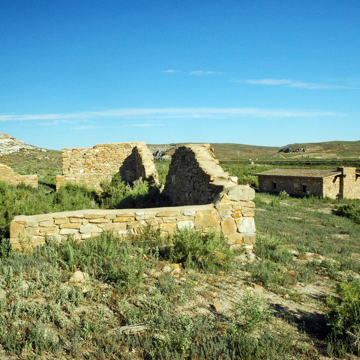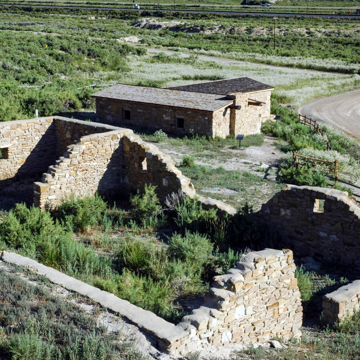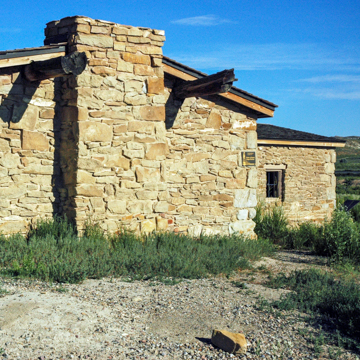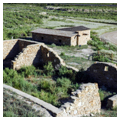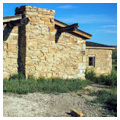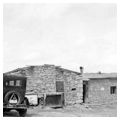Point of Rocks, in the Bitter Creek Valley in southwestern Wyoming, was a daily passenger stop on the Overland Stage line from 1862 until 1868. The one-story Point of Rocks Stage Station was built of native sandstone in 1862. Point of Rocks was a home station, meaning that it provided more amenities than the “swing stations” where horses were changed and passengers given a short break before continuing their journey. The home station served as a place for passengers to rest, receive and send telegraphs (the telegraph line ran through the site), buy supplies, get a meal, and even spend the night if weather or nightfall prevented them from continuing their journey.
The stage stop consisted of a four-room, L-shaped main building, a stable, and a corral. Two types of sandstone chinked with mud mortar were used in construction of the main building: cut blocks of a grayish sandstone at the corners and more random variously-sized pieces of stone, probably gathered from the immediate surroundings, filling in the 16-inch-thick walls. The original roof structure is difficult to confirm since the building burned on at least one occasion, and several of the original beams were replaced with telegraph poles. It is likely that the shallow, 1:12 pitched roof was constructed of wooden poles covered with sod.
The interior is cramped, damp, and dimly lit, with low ceilings and tiny windows. There is a single fireplace in the east wall of the south wing. One room was likely an office and telegraph station, another housed the stationmaster, and the other two were used for feeding and supplying passengers and, in some cases, housing them overnight. Some travelers opted to rest at a nearby sulfur spring where one can still see the names and inscriptions they carved into the soft sandstone.
To the south of the stage station are the stone foundation and partial walls of the original stable, which contained horse stalls and a small room for tack and supplies. Behind the stable and extending to the rock formations beyond was a corral area large enough to accommodate 15-20 horses.
From 1862 to 1866, the line was known as Ben Holladay’s Overland Stage; Holladay sold out to Wells Fargo Express in 1866. With the arrival of the transcontinental railroad in 1868, the Overland Stage was effectively put out of business. However, about that time a new gold field opened directly north of Point of Rocks. From 1868 until 1870, the station was the rail supply point for gold mining towns such as South Pass City and Atlantic City, and the terminal for two stage and freight lines. The 100-mile stagecoach trip to South Pass City took ten hours.
In addition to its original use, the Point of Rocks Stage Station has served as a store, a school, a ranch headquarters, and a residence. In the 1870s Union Pacific section foreman Lawrence Taggart moved his family into the building and his wife turned one of the interior spaces into a schoolroom. One of their daughters married a sheep rancher named Charles Rador, and they resided in the stage station from 1897 until 1910. The last known person to occupy the stage station was Jim McKee, said to have been a member of the Hole-in-the-Wall gang.
In 1947, the State of Wyoming acquired the one-acre site containing the station, stables, and corral. The Wyoming Department of State Parks, Historic Sites and Trails (SPHST) stabilized and partially restored the buildings on the property in 1980. However, 25 years later, the south wall of the stable collapsed and the north wall of the station was in critical condition. SPHST stabilized the foundation, re-pointed the walls, re-roofed the station and reconstructed the south wall of the stable. The Point of Rocks Stage Station is owned and maintained by the State of Wyoming and is open to the public.
References
Barnhart, Bill, “Point of Rocks Stage Station,” Sweetwater County, Wyoming. National Register of Historic Places Inventory Nomination Form, 1970. National Park Service, U.S. Department of the Interior, Washington, DC.
Elwell, R.F. “The Story of the Overland Trail.” The Outing Magazine, The Outdoor Magazine of Human Interest,48 (1906): 67.
Erb, Louise Bruning, Ann Bruning Brown, and Gilberta Bruning Hughes. The Bridger Pass, Overland Trail, 1862-1869: Through Colorado and Wyoming and Cross Roads at the Rawlins-Baggs Stage Road in Wyoming. Littleton, CO: ERBGEM Publishing Co., 1989.
Townley, John M. The Overland Stage: A History & Guidebook. Reno, NV: Jamison Station Press, 1994.

